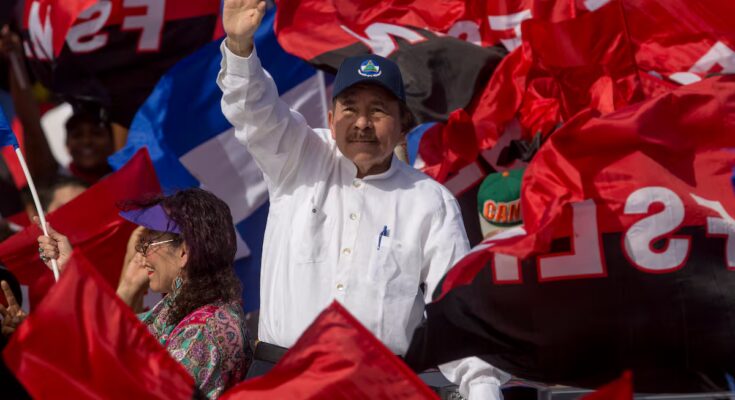In the last stretch before Donald Trump decides whether or not to expel Nicaragua from DR-Cafta, the free trade agreement with the United States vital for the small economy of the Central American country, co-presidents Daniel Ortega and Rosario Murillo accelerate their rapprochement with China. After signing a free trade agreement with Beijing that did not generate the promised revenue, the Sandinista regime has now approved the creation of “Belt and Road Special Economic Zones.” Although the explanatory report of the law sent by the Sandinista executive does not mention the Chinese, the name of the regulation is a clear reference to the global strategy created by President Xi Jinping in 2013, which aims to expand the economic and political influence of the Asian giant through investments in different regions.
“The Government of Reconciliation and Unity promotes the socio-economic development of the country, which it achieves through various strategies, programs and actions such as attracting and promoting foreign direct investment (FDI) and domestic investment, exports, productive diversification, creating formal employment, technology transfer and promoting national competitiveness,” reads the legislation, approved in a context in which the co-presidents have fully aligned themselves with China.
But at the same time, Washington has put the Ortega-Murillo family at a very serious economic crossroads: not only the possible expulsion of DR-Cafta, but the imposition of 100% tariffs on Nicaraguan imports, since an investigation by the Office of the United States Trade Representative (USTR) has determined that the policies, acts and practices of the co-presidential regime are “unreasonable” and constitute a “burden or restriction on trade American,” according to a ruling issued under Section 301 of the Trade Act of 1974.
The Special Zones for Chinese will offer tax and customs benefits to businesses, such as 100% exemption from all their economic activities. But it also proposes a 100% exemption from paying economic activity income tax (IR) for 10 years, renewable every 10 years indefinitely. A position that contradicts, at least ideologically, the narrative of the “sovereignty” of the ruling couple.
They entrusted one of their sons, the presidential advisor for the Promotion of Investment, Trade and International Cooperation, Laureano Ortega Murillo, with the responsibility of the Belt and Road Special Economic Zones. He will be accompanied by six other Sandinista officials.
More incentives for the Chinese
The creation of this onerous regime is in addition to the FTA signed by the Sandinistas with China in 2023, which has fueled trade between these two nations. However, it is laughable compared to Nicaragua’s trade with the United States, which continues to be the main trading partner with over 40% of exports destined for the North American market.
Between January and May 2025, imports from China reached 783.1 million dollars, consolidating the Asian country as the third largest supplier of goods to Nicaragua with a 15.7% share of the total. On the other hand, Nicaragua’s exports to China represent only 1.9% of Nicaragua’s exportable supply destinations ($69 million). This leaves it far behind traditional markets such as the United States and Central America.
In addition to the FTA with China, one of the most tangible outcomes for Nicaraguans has been the invasion of Asian businesses across the country. This has generated a wave of dissatisfaction among local businesses, who feel crowded out by Asian ones, which enjoy a series of tax advantages.
The political analyst and private opponent of his nationality, Eliseo Núñez, explains to EL PAÍS that, although the Special Zones encourage the creation of commercial ties with China, behind this relationship lies the interest in replicating mechanisms of social control. “In the Chinese model, freedoms are limited and the state manages the well-being of the population, albeit unequally and privileging those close to power,” he argues.
He adds: “Even if employment is guaranteed for most poor sectors, this work does not necessarily lead to prosperity, as wages are generally low. This reality forces citizens to depend on the state to access basic services such as healthcare and education, which increases dependence and facilitates social control to the point of reducing the need for physical repression.”
On the other hand, Núñez believes that there will be more benefits for China, because it will bring it closer to the US market, especially if Nicaragua manages to remain in the DR-Cafta. “For China, this represents an opportunity to place Chinese investment goods, manufactured in Nicaragua, on the US market, avoiding tariffs, in the context of the current trade conflict with Washington. Ortega thus uses Cafta to gain advantages on the US market, which he sells to China in exchange for the political and military protection of the Western world,” adds the former MP.
To conclude, Núñez states that the Ortega-Murillo regime appears to have found a way to take advantage of both Western free trade and Chinese social control, “combining both to ensure profits and perpetuate itself in power.”
“However, to achieve this goal, it is necessary to violate several Cafta rules,” warns the political scientist. “The strong centralization of power prevents the existence of internal control mechanisms that allow these violations to be identified and sanctioned, which also affects transparency and the verification of compliance with contractual conditions relating to international loans. Ortega exploits the vulnerabilities inherent in the Western international framework, designed to favor cross-control, by presenting information that activates financing mechanisms and commercial advantages in his favor.”



